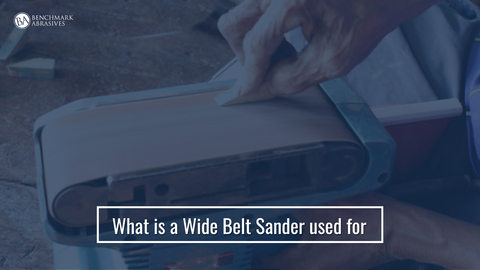
What is a Wide Belt Sander used for

Industrial wood cutting, grinding, sanding, polishing, and finishing applications use a variety of instruments. Wide belt sanders sand wood to get the correct form and surface polish. Below are the specifics of the product's size, design, and characteristics that must be considered when using a sander.
Wide Belt Sander: What Is It?
Among the most widely used equipment for woodworking projects. Broad belt sanders are employed for most sanding and finishing tasks using sandpaper belts. These perfectly constructed sanding tools work well on solid wood to achieve a defined thickness and surface finish.
The operator uses a wide belt sander more often when working on hardwood workpieces since they are simpler to use It makes it possible to work on more surfaces with less burden and cut cooler. Sometimes, the wide belt sander produces lengthy scratches. The time required to fix scratches is excessive. The orbital sander will complete the task faster than it will.
The two drums are covered to use the sanding or abrasive belts in the broad belt sanders. The front drum is free to move, while an electric motor powers the rear drum. These sanders work well for sanding substantial surfaces, removing paint, and grinding wood.
What Is A Wide Belt Sander Used For?
The wide belt sander is used to achieve smooth, spotless surfaces with the proper thickness. Simple to use for finishing tasks on MDF, plywood, and hardwood. The material is placed between the sander table and the sanding belt for sanding. For the required procedures, the feed table's height can be altered. Compared to portable sanders, it produces superior results and works faster.
Pros Of The Wide Belt Sander
- The speed at which abrasive modifications are made supports efficiency.
- Several grit modifications can be used more easily, increasing the versatility of each project.
- Less loading and cooler cutting are benefits of increased abrasive surface area.
- Wide belt sanders will leave long but shallow scratches. With a random orbit sander, the covering of scratches will be considerably simpler and take much less time.
- To give your wooden stock the ultimate polish before using a random orbit sander or staining the surface, wide belt sanders typically come with a platen.
Cons Of Wide Belt Sander
- Greater in cost than drum sanders.
- Greater footprint-more is difficult to travel from one location to another.
- Due to design and rapid operation, dust collection requirements are higher.
- Wide belt sanders feature more moving parts and are, therefore, harder to maintain.
- Smaller pieces must end to end due to the wider area between the hold-down rollers.
- Wide belt sanders require additional maintenance and care to last longer. They have more fragile elements than drum sanders, namely the abrasive belt and platen.
Conclusion
Ultimately, choosing the best sander for your shop or project will depend on a variety of considerations, including your budget, the necessity for portability, the intended use (sanding boards instead of a hardwood floor covered in thick layers of old varnish), and even your level of comfort using the tool. It may only be a matter of deciding which type of sander delivers desired results. This is after conducting a quick search on woodworking forums. Whatever alternative you choose, the most critical thing is to utilize a high-quality abrasive that optimizes machine performance.



































































